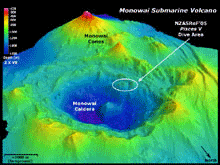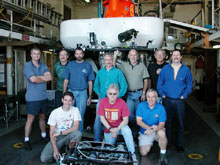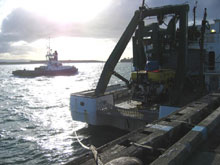
View the slide show of 3D submarine volcano images from the NZASRoF05 Leg 1 expedition dive sites. The dive areas are indicated by the white circles on the images. Click image for larger view.
![]() Click
image to view a slide show.
Click
image to view a slide show.
New Zealand American Submarine Ring of Fire 2005: Leg 1 Summary
April 22, 2005
Bob Embley
Co-Chief Scientist for the New Zealand American Submarine Ring of
Fire Expedition (Legs 1 and 2)
Geophysicist
NOAA Vents Program, Pacific Marine Environmental Laboratory – Newport,
Oregon
Gary Massoth
Co-Chief Scientist for the New Zealand American Submarine Ring of Fire Expedition
(Leg 1)
Principle Scientist
Institute of Geological and Nuclear Sciences Ltd
Lower Hutt, New Zealand
We arrived at the port of Tauranga on the Bay of Plenty in New Zealand after a fantastic three weeks exploring the submarine volcanoes of the Kermadec Arc. We have had eleven incredible dives on five volcanoes during Leg I of the NZASRoF. Here are a few of the highlights of our expedition to date.
A shallow hydrothermal system at one of the Kermadec volcanoes has yielded very high total gas content, equal to the highest values measured at Mid-Ocean Ridge (MOR) sites. Boiling vents produce gas bubbles at 202° C (~400° F) due to the high pressure at venting depth (~2 x the boiling point at sea level). These hydrothermal systems are well within the photic zone at 160-180 meters (~290-330 feet). Schools of fish interact with abundant chemosynthetic life that includes prolific microbial mats and beds of mussels. The high gas content at some arc volcanoes is accompanied on the seafloor by abundant precipitation of sulfur directly from the vent fluids and from small sulfur "flows" oozing from fractures - evidence for direct degassing from underlying magma chambers. This "magmatic degassing" process may be common on submarine arc volcanoes and could lead to new insights into ore-forming processes, including a better understanding of the processes that concentrate gold and other precious and exotic metals.
The extreme and varied chemical and physical conditions within the subsurface and seafloor hydrothermal systems of arc volcanoes are likely to host microbial life with unusual adaptations, including new and unique enzymes. We believe that these have a high potential for developing new, natural products of interest to industrial and medical research.
Results from the present dives on the Kermadec Arc and from the 2004 dives on the Mariana Arc appear to show high productivity of chemosynthetic communities relative to most MOR hydrothermal vents. This may also be due to the enhanced level of magmatic activity of arc volcanoes, which equals more sulfur gases typically.
The chemosynthetic biological communities on the Kermadec Arc are dominated by mussels. Although the individual communities have low biodiversity relative to MOR vents, the biomass at some sites is high and each appears to have a unique combination of macrofauna. A number of species are new records from the New Zealand region, and some may be new to science.
The ongoing seismic activity of one of the Kermadec submarine volcanos prohibited direct study of its cone by the submersibles. Since there is high potential for rich scientific rewards from making observations and sampling fluids from submarine volcanoes, this has prompted an initiative to develop new technology and methods for remote monitoring and time-series sampling of submarine volcanoes with long-term volcanic activity. Studies of extreme oceanic environments such as active submarine volcanoes using new exploration technology could also have important implications and lessons for future remote explorations on other planets and moons in our solar system.
Sign up for the Ocean Explorer E-mail Update List.




























